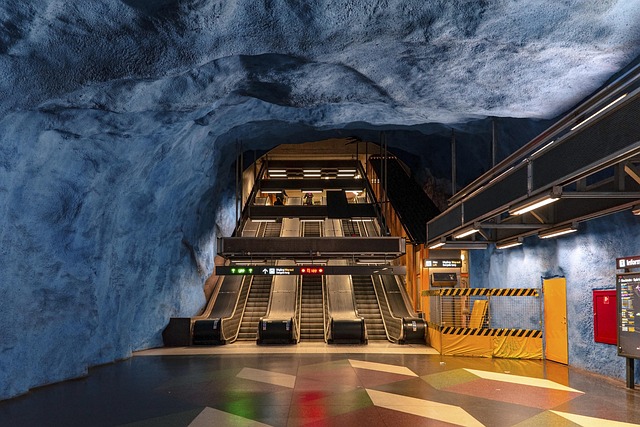Subsurface utility potholing is a modern, non-invasive technique using GPR and EML technologies to accurately map underground utilities, preventing damage during construction. This method replaces traditional, disruptive methods, offering improved efficiency, safety, and project timelines. By leveraging vacuum excavators, GPS, and GPR for precise mapping in urban areas, it minimizes environmental impact and daily life disruptions. Best practices include adopting this tech, implementing digital data management systems, using standardized protocols, and regularly updating information to ensure accurate utility exposure and mapping.
In the realm of infrastructure management, understanding and mapping subsurface utilities is paramount. This article delves into subsurface utility potholing, exploring efficient techniques that revolutionize this critical process. We compare traditional methods with modern innovations, highlighting how advancements like advanced sensing and precise equipment enhance speed and accuracy. Key focus areas include essential equipment, best practices for data management, and accurate mapping. By embracing high-efficiency subsurface utility potholing strategies, professionals can navigate complex networks with enhanced efficiency.
Understanding Subsurface Utility Potholing: A Comprehensive Overview
Subsurface utility potholing is a meticulous process that involves accurately identifying and mapping underground utilities to ensure safe excavation. It’s a comprehensive technique that delves into the unseen world beneath our feet, where intricate networks of pipes, cables, and lines play a vital role in modern infrastructure. This methodical approach is crucial for avoiding costly damage and potential safety hazards during construction or renovation projects.
The process begins with a detailed survey, utilizing advanced technologies like ground-penetrating radar (GPR) and electromagnetic location (EML) to create a digital map of the subsurface utilities. These tools provide valuable data on pipe and cable depths, materials, and locations, enabling professionals to plan excavation strategies accordingly. By understanding the layout of these utilities, workers can safely dig, install, or modify infrastructure without disrupting essential services.
Traditional Methods vs. Modern Techniques for Improved Efficiency
In the past, locating and mapping subsurface utilities relied heavily on traditional methods like visual inspection, physical digging, and manual recording. These approaches were time-consuming, labor-intensive, and often inaccurate, leading to potential damage to underground infrastructure. The introduction of modern techniques, however, has revolutionized utility exposure and mapping, significantly enhancing efficiency and safety.
One such game-changer is subsurface utility potholing. This non-invasive method uses advanced technologies like ground-penetrating radar (GPR) and electromagnetic location to create detailed images of the subsurface, revealing the exact position and depth of utilities. By contrast, traditional potholing methods required extensive digging, which was disruptive, costly, and time-consuming. Modern techniques offer a more precise, swift, and environmentally friendly alternative, allowing for faster project completion and reduced operational costs.
Key Equipment and Technologies in High-Efficiency Potholing
In the realm of high-efficiency techniques for utility exposure and mapping, subsurface utility potholing stands out as a game changer. This advanced method utilizes specialized equipment such as vacuum excavators, which safely and precisely expose underground utilities by sucking away soil using air pressure. By employing this technology, professionals can accurately locate and access pipes, cables, and other critical infrastructure without damaging the surrounding area—a significant advantage over traditional excavation methods.
The process incorporates real-time mapping technologies, including GPS and ground-penetrating radar (GPR), to create detailed digital representations of the subsurface. These tools enable workers to visualize the layout of utilities, making informed decisions during potholing operations. With such advanced equipment, crews can efficiently navigate complex labyrinthine areas, ensuring minimal disruption to both the environment and everyday life in urban settings.
Best Practices for Accurate Mapping and Data Management
To ensure accurate mapping and data management in high-efficiency techniques for utility exposure, several best practices should be followed. One key practice is incorporating subsurface utility potholing, a non-invasive method that uses advanced technology like ground-penetrating radar (GPR) to identify utilities beneath the surface without excavation. This technique significantly reduces the risk of damaging buried infrastructure and provides precise data for mapping.
Additionally, implementing a robust data management system is crucial. This involves organizing and storing data digitally, facilitating easy access and analysis. Standardized data collection protocols and utilizing specialized software designed for utility mapping can enhance accuracy and streamline the overall process. Regular updates and cross-referencing with existing maps are essential to maintain current and reliable information.
In conclusion, high-efficiency techniques for subsurface utility potholing represent a significant advancement in the industry. By adopting modern methods and technologies, such as precise mapping and innovative equipment, professionals can streamline operations, improve safety, and enhance project accuracy. These strategies not only optimize resource utilization but also contribute to more sustainable infrastructure development. Understanding and implementing best practices in subsurface utility potholing are essential steps towards future-proofed utilities management.
